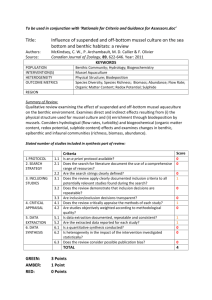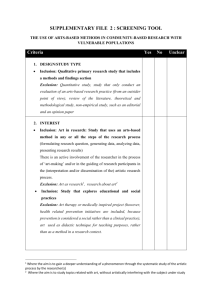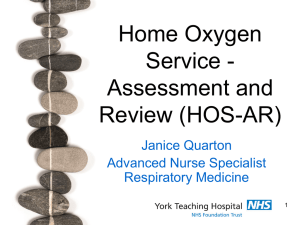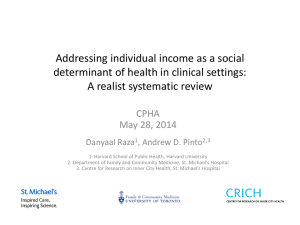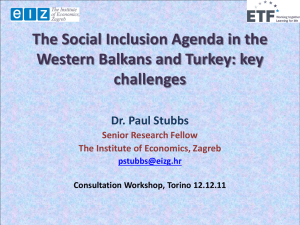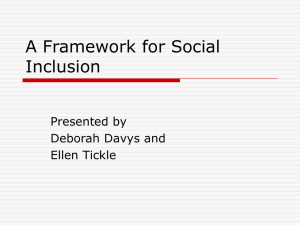Braithwaite-Salvanes
advertisement
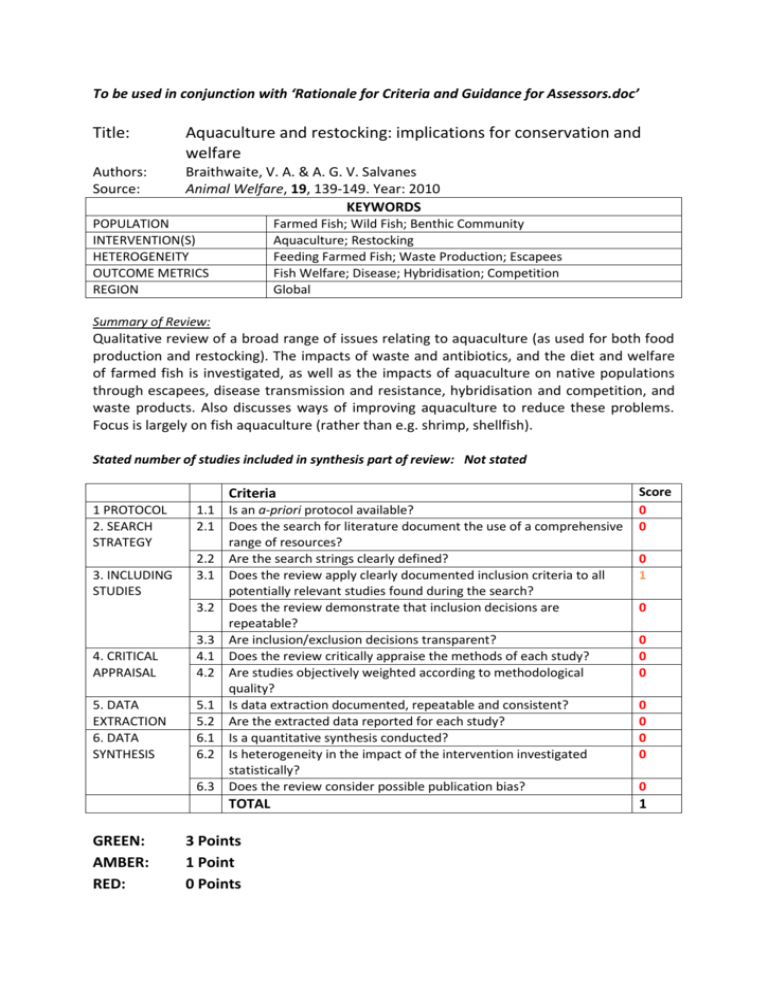
To be used in conjunction with ‘Rationale for Criteria and Guidance for Assessors.doc’ Title: Aquaculture and restocking: implications for conservation and welfare Authors: Source: Braithwaite, V. A. & A. G. V. Salvanes Animal Welfare, 19, 139-149. Year: 2010 KEYWORDS POPULATION INTERVENTION(S) HETEROGENEITY OUTCOME METRICS REGION Farmed Fish; Wild Fish; Benthic Community Aquaculture; Restocking Feeding Farmed Fish; Waste Production; Escapees Fish Welfare; Disease; Hybridisation; Competition Global Summary of Review: Qualitative review of a broad range of issues relating to aquaculture (as used for both food production and restocking). The impacts of waste and antibiotics, and the diet and welfare of farmed fish is investigated, as well as the impacts of aquaculture on native populations through escapees, disease transmission and resistance, hybridisation and competition, and waste products. Also discusses ways of improving aquaculture to reduce these problems. Focus is largely on fish aquaculture (rather than e.g. shrimp, shellfish). Stated number of studies included in synthesis part of review: Not stated Criteria 1 PROTOCOL 2. SEARCH STRATEGY 3. INCLUDING STUDIES 4. CRITICAL APPRAISAL 5. DATA EXTRACTION 6. DATA SYNTHESIS 1.1 Is an a-priori protocol available? 2.1 Does the search for literature document the use of a comprehensive range of resources? 2.2 Are the search strings clearly defined? 3.1 Does the review apply clearly documented inclusion criteria to all potentially relevant studies found during the search? 3.2 Does the review demonstrate that inclusion decisions are repeatable? 3.3 Are inclusion/exclusion decisions transparent? 4.1 Does the review critically appraise the methods of each study? 4.2 Are studies objectively weighted according to methodological quality? 5.1 Is data extraction documented, repeatable and consistent? 5.2 Are the extracted data reported for each study? 6.1 Is a quantitative synthesis conducted? 6.2 Is heterogeneity in the impact of the intervention investigated statistically? 6.3 Does the review consider possible publication bias? TOTAL GREEN: AMBER: RED: 3 Points 1 Point 0 Points Score 0 0 0 1 0 0 0 0 0 0 0 0 0 1 ASSESSMENT 1. PROTOCOL 1.1 Is an a-priori protocol available? If yes, please state the location of the protocol. No 2. SEARCH 2.1 Does the search for literature utilise a comprehensive range of resources? Please state the names and dates of any databases used, as well as any other resources (e.g. bibliographies, websites of relevant organisations, other grey literature sources) No information provided on the resources used to locate articles 2.2 Are the search strings clearly defined? Please provide any information stated by the review that is related to the area of the search (e.g. search strings or broad area of search if specific search strings are not given). Search terms are not defined. The review questions are stated, but there is no documented evidence of a search. 3. STUDY SELECTION 3.1 Do the authors systematically apply clearly documented inclusion/exclusion criteria to all potentially relevant studies located during the search? Please provide any information stated in the review that is related to study inclusion/exclusion (e.g. inclusion criteria or objectives of the review if specific inclusion criteria are not given) Specific inclusion/exclusion criteria are not defined, but the scope of the review is broadly stated: ‘…to highlight issues that we believe are pertinent to conservation and welfare within the context of aquaculture and restocking’. 3.2 Does the review demonstrate that decisions over which primary research articles are relevant to retain following the search are repeatable (e.g. by >1 person applying inclusion criteria and the use of kappa analysis or similar)? Please provide any relevant information on kappa tests, approaches to resolving disagreements etc. No test of repeatability of inclusion/exclusion decisions 3.3 Are decisions over the inclusion/exclusion of each piece of primary research transparent? Please state any information provided by the review in relation to transparency of inclusion/exclusion decisions (e.g. does the review list all studies included and excluded at the full-text stage and give reasons for each exclusion? does the review explain the reasons for the exclusion of some studies but not all?) No explanation of reasons for exclusion of any individual study. 4. CRITICAL APPRAISAL 4.1 Does the review critically appraise the methods of each piece of primary research? Please state what information is provided by the review in relation to the methodological quality of each study (e.g. framework used for critical appraisal, any aspects of methodology that were consistently recorded for each piece of primary research – study design, sampling effort etc.) Methodological information not provided for individual studies 4.2 Are studies objectively weighted according to methodological quality? Please give details of any weighting system used in meta-analysis (e.g. inverse variance, sampling effort etc.) and/or details of any approach to study exclusions based on methodological quality. No evidence for objective weighting of studies 5. DATA EXTRACTION 5.1 Is data extraction documented, repeatable and consistent? Please give details on the metrics extracted to assess the impact of the Intervention (species richness, biomass etc.) and indicate whether the review consistently extracts a defined set of metrics from each study. No evidence for the a-priori extraction of specific data, and the metrics extracted from each study are not presented systematically 5.2 Are the extracted data documented for each study? Please state whether or not the Population, the Intervention, and the Outcome are given for each study (information may be in the main body of the review, or in any Appendices/Supplements) Outcome metrics are not documented for each study 6. DATA SYNTHESIS 6.1 Is a quantitative synthesis conducted? Please indicate whether the review uses a metaanalysis (or similar technique) to synthesise the findings of each study statistically, a quantitative synthesis without statistical analyses (e.g. results are synthesised using descriptive statistics and graphs only) or a qualitative synthesis. Qualitative synthesis 6.2 Is heterogeneity in the effect of the Intervention investigated statistically? If yes, please state what the main effect in the study was (primary question being studied) and what aspects of heterogeneity in this effect were considered (e.g. differences between taxa, regions, types of interventions etc.) No quantitative investigation of heterogeneity in effect 6.3 Does the review consider possible publication bias? If yes, please describe the approaches used (e.g. Egger test, calculation of failsafe numbers, use of raw data etc.) No evidence that publication bias has been objectively considered.
